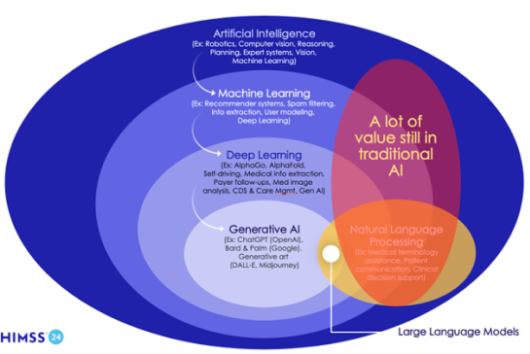Article
Your Patients Want More Time with You, And AI Can Help
February 29, 2024

The state of healthcare today: unbridled burnout.
Some of the healthcare industry’s biggest challenges today are centered on lack of resources needed to make a practice run. Turnover rates are high, there’s a shortage of labor, and the remaining physicians at hospitals and medical offices across the U.S. are faced with overwhelming amounts of work. Many healthcare workers across the country are disillusioned with the state of healthcare, and many believe that we’ve already hit a breaking point.
But what if technology could help reduce some of this burden? What if automation and intuitive machine learning could take administrative work off physicians’ plates, allowing them more time in their day and focus on patient care, instead of documentation and administration?
The answer? The right technology already is.
Advancements in artificial intelligence can strengthen doctor-patient relationships by reducing time spent on admin work, notetaking, and claim resolution. That means more provider focus on what matters most: the patient.
Let’s take a closer look at how AI is starting to transform the state of healthcare today, including where Generative AI fits in the broader ecosystem.

New technology is helping solve the right problems with AI
Many physicians believe that AI has the potential to help solve this burnout epidemic in the U.S. Over a quarter (26%) of physicians surveyed think AI may help to reduce physician burnout.2 And research shows that their patients think the same— according to a separate survey fielded by Dynata, more than half of patients surveyed believe AI will be part of the solution in healthcare, and 42% believe AI can help improve patient health outcomes.3
However, a general lack of understanding about how AI works, and how it's being used in healthcare is causing patients to fear the potential of a lack of human touch.4
The truth may be the opposite. By integrating AI and automation into daily workflows and patient encounters, physicians can spend more focused one-on-one time with their patients, strengthening the relationships and delivering better care.
How does this work? By leveraging AI and machine learning to help reduce work on time-consuming administrative tasks like notetaking and updating medical history, and increase regular communication with patients via personalized, automated messages from their physician to help them on their health journey. For example, you can convert patient encounters into clinician notes and updated medical history via AI voice-to-text. Let’s dive a bit deeper.
So, what does AI in healthcare actually look like?
You may be wondering what the practical application of AI and automation looks like for physicians today. To start, here are a few examples of how hospitals and enterprise-scale healthcare organizations have already begun implementing this technology:
- Synthesizing and understanding unstructured data sets such as diagnostic images, scans, and medical charts5
- Optimized scheduling and personalized outreach for patients to help ensure continuity of care
- Translating doctors’ notes and discharge instructions into a patient’s native language
- Early detection to help diagnose cancer and other diseases from MRIs and CT scans6
These examples help illustrate just how much possibility lies in incorporating AI and automation into physicians’ daily workflows. 77% of physicians surveyed say a significant portion of their time is dedicated to non-reimbursable tasks like prior authorization, or insurance-related workload7, so the opportunity to create new efficiencies, increase productivity, and increase revenue with the help of AI is massive. The question is: can healthcare organizations afford to forgo this opportunity in order to keep using outdated, stagnant technology?
The emerging benefits of AI in healthcare
Research suggests that there are some pretty impactful benefits of incorporating AI into patient encounters and daily workflows. Let’s examine this a bit more closely.
According to our recent Physician Sentiment Survey, 42% of respondents specified that identifying patterns and anomalies in patient data was a key benefit of using AI technology, and 39% noted benefits in reducing administrative burdens and streamlining tasks.8 But what other advantages have hospitals and physicians seen after implementing this new technology?
To name a few:
- Reduced turn-around times for clinician notes
- Increased efficiency during patient interactions so clinicians can spend more time with patients
- Quicker, more accurate patient diagnoses
- Personalized outreach and treatment plans for patients
- Real-time patient data monitoring9
In addition, learning algorithms allow generative AI to become more advanced and accurate over time with human interaction to help train them. That means that the longer you use AI, the better results you’ll gain. However, it’s important to be mindful of a few considerations: generative AI requires some level of human involvement in order to learn and improve, so resources should be allocated to help monitor and train the technology. Additionally, IT leaders within healthcare organizations should help ensure that patient data remains secure, and all use is HIPAA compliant. Secure, privately-owned instances of an AI tool are one way to confirm that PHI isn’t mingled with broader data.
So, now that we’ve examined the practical uses and benefits, let’s look at how your healthcare organization can start using AI in your day-to-day.
Three examples of how to incorporate AI into your daily workflow
1. Automation of clinical notetaking
Let’s say that you’re the CEO of a privately-owned clinic for obstetrics and gynecology. You’ve noticed a decrease in productivity recently during patient encounters. Physicians are spending a surplus of hours during the week just on notetaking alone, and as a result you’ve been getting signs that patient satisfaction is decreasing due to burnout and lack of one-on-one time. So, your ob-gyn clinic decides to implement new AI technology that would help automate these clinician notetaking tasks during daily patient encounters. Physicians can now dictate a patient’s medical history, symptoms, and health plan to an AI notetaking app on their computers that generates accurate clinical notes in real-time, allowing them to spend more focused time caring for their patients.
2. Diagnosis and early detection
What if you’re heading up a healthcare organization that specializes in cancer detection and genetic testing, and you want to improve accuracy of patient diagnoses? While some physicians at your organization might be skilled in identifying possible growths and malignant cells from scans and MRIs, you’re concerned about the risk of human error and how it might affect the lives of patients. So, your healthcare organization decides to start leveraging AI technology to help scan high volumes of unstructured data sets like MRIs and CT scans to help identify patterns and anomalies. This way, your organization ends up increasing your rate of accuracy and helps to ensure the quality of physician diagnosis.
3. Personalized patient outreach
Lastly, let’s say you’re a large healthcare organization that’s taken on many new patients in the past year. You want to help increase your rate of patient engagement, as you’ve been noticing some gaps in doctor-patient communication, leading to care gaps later down the line. To help solve this, your enterprise organization decides to integrate AI to help synthesize patient medical data so clinicians can create automated, personalized patient outreach in your patient portal. Now, this new technology uses patient medical records to generate tailored messages to each patient with follow-ups and treatment plans, allowing patients to communicate more often with your organization.
Reduce documentation time with athenahealth voice-powered solutions
With these examples in mind, we’d like to demonstrate how athenahealth is already using AI technology to help reduce documentation time and prevent clinician burnout. athenaOne Dictation and athenaOne Voice Assistant powered by Nuance use voice-to-text to help you accurately document patient care and reduce time spent on clinical notetaking. You can move between patient encounter fields more efficiently using simple voice commands, and there’s no need to change how you document. Pre-existing global and custom macros, templates, and accelerators can support your preferred documentation style, and it’s mobile-friendly, so there’s no need to carry a laptop between patient encounters.
By integrating athenaOne Dictation and Voice Assistant into your daily workflows, you can rely on quick, accurate documentation while freeing up more time to spend on direct patient care. This way, you can leverage AI technology to bring you closer to your patients.
Instances of AI technology in healthcare are still developing day by day, but the opportunity to address the current pain points of the healthcare industry is massive, and one that the healthcare industry can’t afford to pass up. Physicians can help educate their patients on the benefits of AI and how they’re using this technology in their day-to-day, so patients feel more informed about its use. Starting with automation can help your healthcare organization ease into integrating generative AI into your healthcare tech, while also seeing big benefits. You don’t have to wait for the future of AI to start streamlining your workflows with athenahealth.
Learn more about how athenaOne integrates AI and automation into our solutions.
1. 2023 Physician Sentiment Survey, commissioned by athenahealth and fielded by Harris Poll, Jan 2024
2. Ibid
3.Patient Perception of AI, commissioned by athenahealth and fielded by Dynata, Nov 2023
4. Ibid
5. 2023 Physician Sentiment Survey, commissioned by athenahealth and fielded by Harris Poll, Jan 2024
6. Forbes, “How Healthcare Clinicians and Researchers Are Using Generative AI”, Feb 2024
7. 2023 Physician Sentiment Survey, commissioned by athenahealth and fielded by Harris Poll, Jan 2024
8. 2023 Physician Sentiment Survey, commissioned by athenahealth and fielded by Harris Poll, Jan 2024
9. Ibid



